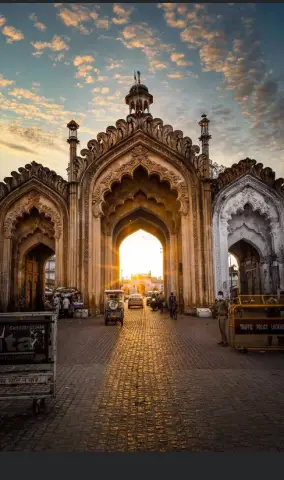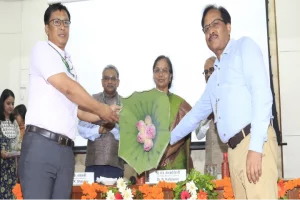One of the most nuanced heritage cuisines of India is Avadhi — and though it is also one of the most popular cuisines these days, the taste of true Avadhi food is fast disappearing, overtaken by a pastiche of kebab-biryani menus, roughly produced but that do not quite get the sophistication and subtlety that were the hallmarks of this luxurious aristocratic cuisine of India.
Highly paid chefs or rakabdaars who had once produced the silken gravies, melt in the mouth morsels, lamps made with coloured sugar so cunningly crafted that they looked like the real thing, pulaos with “pearls” and more were a product of a culture that has long faded. As patronage has disappeared, and tastes changed, the subtleties of Lucknowi food have been replaced by overpowering spices, kewda, and mirch-masala, all the things which most definitely do not constitute Avadhi food. A once elite cuisine has been rendered touristy, a pale imitation of what it was, and what it can be if revived.
What was Avadhi food? And if you happen to stumble upon some dishes, how can you judge whether they are well-cooked or just some spicy pastiche?
To understand any cuisine, we must understand the people and their culture that produced that food. If you have watched, or read, the classic Shatranj Ke Khiladi, based on a short story by Munshi Premchand, written in 1924, you may have a sense of what Nakhau, the nawabi capital, was in its last opulent days as political power shifted to colonial forces, and a feeble nobility looked more and more inwards to a life built around aesthetics and yes pleasure seeking. This was perhaps escapism or merely the last long sigh of a tradition of luxury spanning over a century and more.
For an relaxing look at the Awadh of Wajid Ali Shah, I recommend watching Munshi Premchand’s story set ti the silver screen by Satyajit Ray (and outstanding music) “Shatranj ke Khiladi” ” The Chess Players”https://t.co/bJQ9KQX19t pic.twitter.com/ZV9duAj2le
— Rupak Chattopadhyay (@RupakChatto) October 1, 2021
At the height of its power and glory, Lucknow, the new capital of the nawabs, who moved from Faizabad to this newly built capital, was a cosmopolitan and rich city; an oasis of stability in the Indian Subcontinent, at a time when Mughal power in Delhi was fading. These subsidiary rulers, who still owed nominal allegiance to the Mughal emperor at the Red Fort, were able to carve out an empire within an empire, with various “rajas” or rich landowners of the Indo-Gangetic plain contributing to their wealth through incomes gained from vast tracts of farming land.
Artists, poets, and cooks gravitated to this new capital, as also merchants, both Indian and foreigners. The rajas too built their stately mansions in the capital. And as a result of this intermingling, Avadhi food was “constructed” as tastes and skills of a diverse community of people, both Indian and international, came together patronised by the wealthy elite.
Abdul Haleem Sharar, one of Lucknow’s most famous writers of the late 19th century—the city was quite the literary capital of the northern Indian subcontinent too, with the likes of the Naval Kishore press– gives an account of the cultural life of the city in his classic Guzashta Lucknow. A collection of 54 articles, the tome tells the story of Lucknow and its rulers, and the life of the elite in the late 18th and 19th centuries.
These books on Lucknow are available in English/Hindi:
1. Guzashta Lakhnau – Abdul Halim Sharar
2. Taaoos Chaman ki Maina & Ganjifa – Naiyer Masud
3. Chandni Begum & Gardish-e Rang-e Chaman – Qurratulain Haider
4. Khwab Sarab by Anees Ashfaq , English trans. ‘Dream Mirage’1/3
— Iqtibas اقتباس (@iqtibaas88) December 21, 2022
It is here that we come across the term “rakabdar” for head chef, highly paid in aristocratic homes, highly skilled artisans who would rule the household with their cooking, inventing clever dishes of great refinement. There were some bazaar dishes which were also bought for each meal but the bazaar cooks were neither as skilled as the rakbabdaars nor valued as much.
As the city flourished, its society immersed itself in the pursuit of refinement in all spheres of life. Elegance and manners became everything—from fine clothing and chikanwork embroidery, to eating paan and the pehle aap culture of politeness which is stereotyped and mocked.
In many ways, the exaggerated codes of conduct were like those practiced by the upper classes in Regency and Victorian England where gentlemen spent hours tying knots to their cravats and their butlers’ hours polishing Hessian boots. In Lucknow, gentlemen spent hours perfecting the paan. How to eat and offer the betel leaf, an ancient Indian mouth-fresheners present in all parts of the country, and that became an art form. Intricately carved silver boxes for the leaves and their many accoutrements were carried around by bearers even when a nobleman visited other homes. And an elder or senior person offering it to a social inferior was an honour.
Let us introduce you to another salient feature of Avadh, the traditional Paandan. From simple one-layer boxes to elaborately carved designs in brass and silver, the Paandan of Lucknow has undergone many changes over the years.
Preparing a paan is a feat that takes time and… pic.twitter.com/ZJlyxIXSJL
— Maroof | Heritage, Storyteller (@maroofculmen) May 26, 2023
On the other hand, silken textures of food developed because chewing anything visibly was considered impolite! So, gravies without wholes spices or bits of spices floating in them were carefully prepared by the clever cooks.
The kitchen in fact had a rank of cooks organised according to their skills and the work they did, pretty much in keeping with the French system. A masalchi for instance would only pound the spices to fine powders. A qorma chef was the equivalent of the saucier, and the head chef was the rakabdar. A hakeem with knowledge of unani medicine, itself based in Ayurveda, the ancient Indian system of healing through foods, would advise on which spice or “bhasm” (ash of precious metals or pearls) to include in the food to promote health, virility, cool the system and the like.
All these manners, rituals and beliefs are part of Avadhi food that we know today. The many fabled 100 plus masalas of a galawat ka kebab (made by Tundey mian) or the “secret” spices of a qorma that tourists eat or which are trendy on Instagram, the “Lazaat e Taam” that foodies search for in Lucknow, all go back to the hakim who would make up recipes and advise the head chef to incorporate these in the food— a root, pearl ash, rose petals et al. The almost mystical quality associated with Avadhi masalas and the cult of secrecy goes back to these secret nuskhas promoted as mythic elixirs for the wealthy.
Because it was considered impolite to chew, the spices were finely powdered. And techniques such as sieving the gravy, or boiling onions to extract just the water and reduce the pungency were invented by cooks contributing to the refinement that is a hallmark of Avadhi food.
One distinguishing feature of Avadhi food from that of old Delhi and Rampur, which are both similar, is the fact that no whole masalas are used in Avadhi. And that comes from the emphasis on manners in public life—no spitting out or chewing needs to be involved. Avadhi food is also more fragrant than spicy (or chilli) on the tongue unlike southern Indian food because its society did not want to reek of spices post a heavy meal! Unlike the southern Indian biryanis, Avadhi biryani, more legitimately a pulao, is subtle and fragrant and should not taste “spicy” at all!
Ghalib, the great Mughal poet, who fled to Lucknow after Delhi’s destruction by the firangi forces in 1857, describes the many different types of pulao on the Avadhi table: There was the koku pulao (named after the cuckoo), moti pulao (after pearls or the pearl-like motiya flower) and scores of other varieties named after nature’s beauties. In their place, tourists in Lucknow now seek out the biryani. The Avdhi biryani is a pulao, essentially. Unlike the biryani, which is a one pot dish in Hyderabad and the south (meat and rice with spices are all cooked together), the Avadhi pulao, a descendant of the Mughal dish, is cooked in two stages; once where the meat is cooked and its stock strained and reserved, and then the rice is cooked in the stock separately. Finally, these are assembled and finished on dum, a steaming technique that too was perfected in Lucknow.
One way in which you can judge an Avadhi biryani is how it is spiced. It should be fragrant, without an overpowering taste of spices and only mildly scented with the likes of cardamom, roses, kewda or the now pervasive itr, all of which used to be made in Kannauj, the capital of perfumery in India. The rice used is basmati, originally cultivated for the nawabs in Terai, and cooked so that each grain shines (lime juice is added to clean impurities, and milk in the cooking process to lend its aroma). Saffron was used to colour a few grains so that it resembled flower petals. That is the genesis of the ghastly orange coloured commercial, oily biryani you may eat today.
While Avadh refined many of the Mughal dishes of Old Delhi, we must not forget this is a unique cuisine because of its cosmopolitanism. French and local influences from the countryside of the ganga-jamuna belt, food cooked in the homes of the rajas, all have contributed to what we today know as Avadhi.
French mercenary soldiers and tradesmen were a substantial presence in 18th-19th century Lucknow, with the ladies buying French luxury goods, including chiffons and lace. Claude Martin, born in Lyon, who worked with both the French East India Company and the British East India Company as a soldier was employed later by Shuja-ud-daula. But his architectural skills were also in demand, and nawab Asaf-ud-daula, under who Lucknow saw its artistic (and culinary) flowering, gave him a chance to participate in the building of the modern Lucknow. Many buildings in Lucknow have his French imprint, including Constantia, his country palace, now La Martiniere, the boy’s school (the girl’s school is my alma mater).
As this influential Frenchman entertained both Lucknow nobility and British East India Company top brass, it is not hard to understand the culinary exchange which may have taken place to give Avadhi food a Lyon (Claude Martin was from Lyon) touch, in terms of techniques, if not taste.
The French bouquet garni is in fact like the Avadhi potli masala (discovered by Insta foodies these days as the powdered lazzat e taam). It is impossible to say what came first. The technique of scenting stews with herbs and seasoning tied in a bundle that we find in French Classic dishes such as boeuf bourguignon, a speciality from Burgundy, seems to have come about only in the mid- 19th century. Avadhi cuisine was already enjoying its heyday at this time.
There’s a kitchen witchery version of charm bags, In French cooking terminology, you might know these as bouquet garni: wrapped bundles of herbs to flavour soups, stocks, teas & milk drinks. It’s a long-held magickal belief that herbs can heal us, inspire us, & protect us #herbs pic.twitter.com/MNJpOwxbNU
— Calleenscrafts (@Calleenscrafts) June 24, 2020
With the Lucknowi aristocracy mindful of its delicacy (not chewing in public, not reeking of heart masalas), potli masala was the perfect invention, enabling the leeching of fragrant spices into a bubbling stock. Did the technique of tying spices into a bundle in a muslin cloth that was a Lucknowi invention for its pulaos impact the creation of the French boquet garni? Or, was it vice versa?
At any rate, a classic of cooking from Burgundy in the south of France (Lyon was part of the kingdom of Burgundy) is the boeuf bourguignon. Unlike what most people believe, it is not a very old dish, and became a classic only in the 20th century with Julia Child. Its first recipe only appears in the 1860s. It incorporates the boquet garni as well as what we may call dumpukht in Lucknow.
Before this, casserole dishes in Burgundy were made with cold leftover meats– instead of stewing meat and vegetables together slowly in a baking technique that closely mimics the dumpukht style of cooking of Lucknow of the 19th century. In fact, just like in dum cooking, where Indian master chefs covered a bubbling stew/yakhni/pulao with dough, sealing the deep degchi or lagan to retain the juices, the classic French recipe too uses the same sealing technique. Meanwhile, the ishtew itself is an old Delhi invention, a borrowing from European stews of the late 18th century, but been improvised by Indian cooks.
Galawat ke kebab, literally connoting tenderness, may have a French influence. The genre includes both the galauti, made on a tawa, and kakori made on the horizontal sigri grill (not the Punjabi tandoor from central Asia) but these kebabs are distinct because of a higher fat content added to the mice contributing to their silken texture. This may be an influence of the pate of French cooking where fat is added to the chopped meats. The galauti and kakori are Lucknowi improvisations of the Mughal shami and seekh which have more texture, and in my opinion, given the huge French presence in Lucknow, the tender finish is a French influence incorporated into what existed—never mind tall tales of toothless nawabs.
Galawat ke kebab paired with @GHMUMM at the #Awadhi meal #Lucknow @TajLandsEnd #bandra #mumbai #luxury #food pic.twitter.com/FgQDHEMDQq
— Monsieur George (@riaangeorge) February 15, 2016
In fact, many old accounts, not the least by Englishwomen who married nawabi elite talk about how in many homes a European kitchen existed alongside an Indian one, contributing to an exchange of ideas obviously, later also seen in Calcutta and its food.
The foods of the countryside and their heavy dependence of milk and milk products too contributed to the 19th century creation of Avadhi food. We see this not only in the cooking of all sorts of dishes where khoya enriches recipes but even in something like the malai paan, or paan ki gilori, the mithai Lucknow is famous for, along with nuqti (fine boondi) laddoos and more. “Balai” is the nawabi term for the top layer of thick cream. And this was a favourite with the rich—its sheets used cunningly to mimic a paan ki gilori stuffed with chironjee, kishmish and dried coconut also lacing meetha paan.
And finally, chaat. With a cosmopolitan population snacking in the evenings (chaat is an evening pastime only), the food of older cities such as Agra and Benares were incorporated into the chaat-kachori (kachori-subzi is a morning tradition) of the streets. But as with everything, the Avadhi culture of refinement gave both refinement in names and tastes and textures to the chaat of the provincial towns. Paani ke batashe, “tikiya” and so on are terms which are not rustic and connote a certain urbaneness.
Green peas have been present in India since at least 3500 years, and are thought to be indigenous to India. One of the main regions in which they grew as a legume crop is the gangetic basin, by the 2nd century BC. This matar is seen in a number of dishes of eastern UP such as nimona and fresh sautéed peas were a winter delicacy in Avadh too, across communities, and also as part of stuffed parathas. These are foods that you do not get in any restaurant but are as much Avadhi as any kebab.
Dried white peas that contain more starch than young green peas and can be stored longer were traditionally eaten as food by the poorer people of eastern Gangetic plain. When this countryside ingredient entered Lucknow, it was given a twist. Matara, or Matar ki chaat is a quintessential Avadhi chaat, where dried peas are boiled and then made into a spiced mash that is pan-fried on tawas as a tikiya or faux kebab. At places such as King of Chaat, the quintessential chaat shop for wealthy old-timers, you will still find it being served with just a dash of lime and ginger—not dahi and saunth.
As potatoes came in, as a new European crop grown in the foothills of Uttarakhand (there is a mention of Warren Hastings receiving a gift of potatoes from the Nawab of Avadh), inventive cooks made this in a tikiya too, eaten widely as chaat today.
Avadhi food then was perhaps one of the first to emerge from a modern cosmopolitan city in India with foreign and local influences—India’s first modern cuisine, and not the stereotype you would associate it with today.
Also Read: The birth of the iconic Butter Chicken in Delhi’s Daryaganj




















